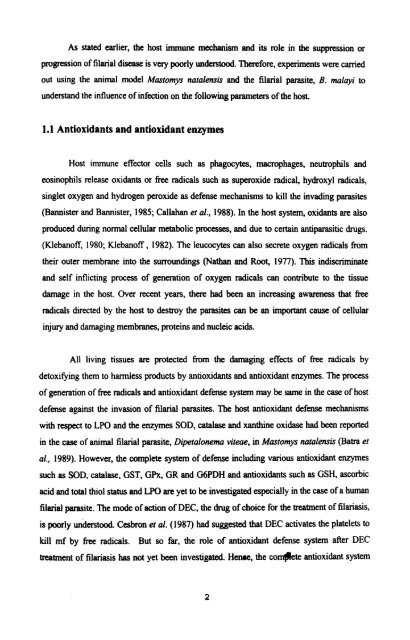effect of infection of the filarial parasite brugia malayi - Pondicherry ...
effect of infection of the filarial parasite brugia malayi - Pondicherry ...
effect of infection of the filarial parasite brugia malayi - Pondicherry ...
You also want an ePaper? Increase the reach of your titles
YUMPU automatically turns print PDFs into web optimized ePapers that Google loves.
As stated earlier, <strong>the</strong> host immune mechanism and its role in <strong>the</strong> suppression or<br />
propsion <strong>of</strong> <strong>filarial</strong> disease is very poorly understood. Therefore, experiments were carried<br />
out using <strong>the</strong> animal model Mastomys natalensis and <strong>the</strong> <strong>filarial</strong> <strong>parasite</strong>, B. <strong>malayi</strong> to<br />
understand <strong>the</strong> influence <strong>of</strong> <strong>infection</strong> on <strong>the</strong> following parameten <strong>of</strong> <strong>the</strong> host.<br />
1.1 Antioxidants and antioxidant enzymes<br />
Host immune <strong>effect</strong>or cells such as phagocyks, macrophages, neutrophils and<br />
eosinophils release oxidants or free radicals such as superoxide dcal, hydroxyl radicals,<br />
singlet oxygen and hydrogen peroxide as defense mechanisms to kill <strong>the</strong> invading <strong>parasite</strong>s<br />
(Bannister and Bannister, 1985; Callahan et al., 1988). In <strong>the</strong> host system, oxidants are also<br />
produced during normal cellular metabolic processes, and due to certain antiparasitic drugs.<br />
(Kleban<strong>of</strong>f, 1980; Kleban<strong>of</strong>f , 1982). The leucocytes can also secrete oxygen radicals from<br />
<strong>the</strong>ir outer membrane into <strong>the</strong> smundiigs (?-lathan and Root, 1977). This indiscriminate<br />
and self inflicting process <strong>of</strong> generation <strong>of</strong> oxygen radicals can contribute to <strong>the</strong> tissue<br />
damage in <strong>the</strong> host. Over recent years, <strong>the</strong>re had been an increasing awareness that free<br />
radicals directed by <strong>the</strong> host to destroy <strong>the</strong> <strong>parasite</strong>s can be an important cause <strong>of</strong> cellular<br />
injury and damaging membranes, proteins and nucleic acids.<br />
All l~ving tissues are protected from <strong>the</strong> damaging <strong>effect</strong>s <strong>of</strong> free radicals by<br />
detoxifying <strong>the</strong>m to harmless products by andoxidants and antioxidant enzymes. The process<br />
<strong>of</strong> generation <strong>of</strong> free radicals and antioxidant defense system may be same in <strong>the</strong> case <strong>of</strong> host<br />
defense against <strong>the</strong> invasion <strong>of</strong> <strong>filarial</strong> <strong>parasite</strong>s. The host antioxidant defense mechanisms<br />
with respect to LPO and <strong>the</strong> enzymes SOD, catalase and xanthine oxidase had been reported<br />
in <strong>the</strong> case <strong>of</strong> animal <strong>filarial</strong> <strong>parasite</strong>, Diperalonema viteae, in Mastomys natalensis (Barn et<br />
a/.. 1989). However, <strong>the</strong> complete system <strong>of</strong> defense including various antioxidant enzymes<br />
such as SOD, catalase, GST, GPx, GR and G6PDH and antioxidants such as GSH, ascorbic<br />
acid and total thiol status and LPO are yet to be investigated especially in <strong>the</strong> case <strong>of</strong> a human<br />
<strong>filarial</strong> <strong>parasite</strong>. The mode <strong>of</strong> action <strong>of</strong> DEC, <strong>the</strong> drug <strong>of</strong> choice for <strong>the</strong> mtment <strong>of</strong> filariasis,<br />
is poorly understood. Cesbron et (11. (1987) had suggested that DEC activates <strong>the</strong> platelets to<br />
kill mf by free radicals. But so far, <strong>the</strong> role <strong>of</strong> antioxidant defense system after DEC<br />
treatment <strong>of</strong> filariasis has not yet been investigated. Henoe, <strong>the</strong> comfkte antioxidant system

















